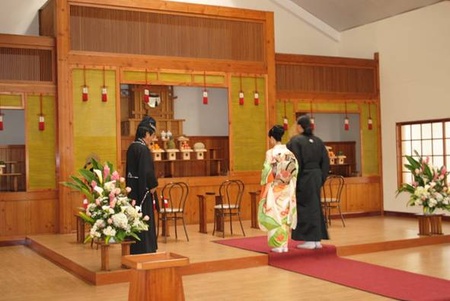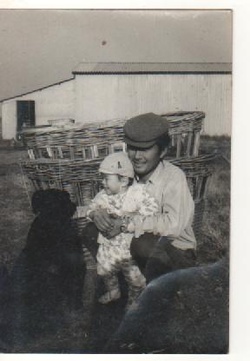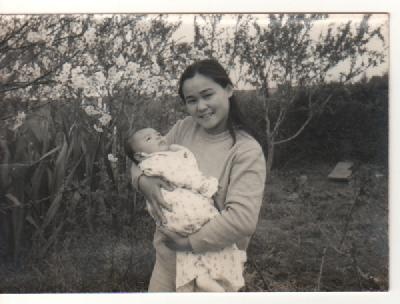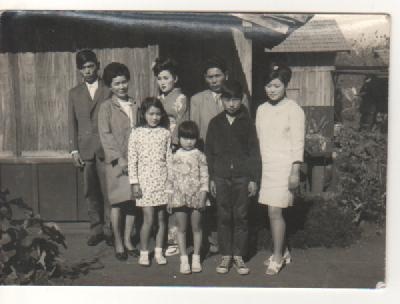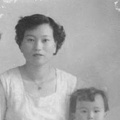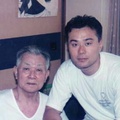This is an overview of the traditions regarding birth, marriage and death within the Japanese community of Colonia Urquiza and surrounding areas.
Introduction.
Communities outside their country of origin transfer their customs, on this occasion the process of family life from the country of origin and the receiving country will develop.
In Japan, in each Province, in each Prefecture ( Ken ), in each city ( Shi ), the births of Japanese citizens are registered in "Family Boxes"; that is, in files where the nuclear family is registered. As abroad, Consulates also fulfill the same function. Therefore, the koseki is the family record. Japanese Law requires all Japanese houses (IE) to register births, acknowledgments of paternity, adoptions, unions, divorces and deaths with their local authority, to enter it in the koseki , achieving legality. 1
In general, the Japanese wedding ceremony is familiar and is characterized by maintaining a ritual, such as sake, where dressed in special kimonos, they perform an act of union by drinking sake in cups or in a temple where a monk officiates the ceremony. Nowadays, out of fashion, many people who are not Catholics marry in the West or in Catholic Churches and there are those who profess this religion.
Regarding deaths, in the Japanese tradition, a vigil is held with the body present, with family and friends attending, and giving the family an envelope with money to help with the expenses of the wake, burial or cremation, and after 49 days a meeting is held where (with the ashes or just a photo of the deceased) tribute is paid, with a Buddhist monk (bonze) who recites sutras, as spiritual exercises, invoking Amida Buddha, in memory of the ancestor. Food is presented to it and a certain mourning is observed during those days. Another meeting is held every year because the soul returns once again.
The Japanese Family.
Over the past fifty years, the family in Japan has undergone structural changes. 2 In 1898, the Civil Law implemented the “ koseki ” or birth registration, where the firstborn was granted the right to inherit all family property. Japan began to copy the customs of families from Western countries, such as the role in which the woman was a housewife ( shufu ) and her most important duty was to strive at home for peace and harmony and to form good citizens, He began to have the privilege of working and providing income.
In 1948, a law was enacted that expressed basic human rights, the equality of both sexes, etc.
After the economic crisis of 1973, one in every two married women worked, because otherwise they could not maintain the standard of living they had achieved, which caused women to acquire greater independence. In 1975, the International Women's Year was declared, which aimed to improve their situation. Other global efforts were: the Convention for the Abolition of all Forms of Discrimination Against Women in the United Nations of 1979, the Equal Employment Opportunity Act for both sexes in 1985. The birth of this law was not easy because there was very strong opposition from the conservatives, since they always saw women at an inferior stage compared to men.
In 1999, the cooperative participation of men and women in society was resolved; For the first time, the participation of both sexes in social activities is promoted. It also refers to the family, as it clarifies that both men and women must take charge of raising their children and other activities at home.
In Japan, according to statistics, people no longer get married so young. Young women have found that being single they are freer, and men value that being single they have more money. Many young single people live with their parents depending in some way financially on them, and there are even cases of men who live with their partner, leaving the woman to be the one who provides the finances in the house and they stay at home doing the chores. work as housewives.
In 1997, the divorce rate was still lower, but over the last few years this has changed. There is even what is called divorce within the home or dysfunctional family; They are the couples who do not speak or who do not have relationships.
There are also cases of Japanese, both men and women, who cannot start a family in Japan, so they look in nearby countries with whom to marry and have children. But there are also those descendants of Japanese, born abroad, who are looking for a husband or wife in Japan.
Registration abroad according to community interviews.
Japanese born abroad, if they want Japanese citizenship, must complete a procedure at the Japanese Embassy or Consulate by filling out the corresponding forms. Beforehand, you must request the original birth and family certificate ( koseki shohon and koseki tohon ) in Japan, at the Prefecture, for the process, which is inviolable and takes two weeks.
When a baby is born and the parents want to register it to obtain citizenship, if they are Japanese (native, issei), or children (second generation nisei with koseki , that is, with citizenship) or of Japanese blood (nikkei), they must process during the month of birth your citizenship, presenting the father's/mother's certificates (requested from Japan, to the Prefecture), the child's birth certificate and marriage record. The process takes approximately one year.
If the surname is of another origin, for example, a Western Italian father, a Japanese mother or descendant, when it is registered, the surname must always be Japanese, it is the one that is taken into account for the entry in the “Family Box”. When a family loses its surname, because there are no male heirs, only female descendants, in Japan it is accepted that when women marry Japanese (especially the eldest daughter), they can keep their surname, that is, the man takes the his wife's last name ( Yoshi ) and becomes part of the woman's “Family Box”.
Abroad, the legislation does not contemplate changing the surname, although there may be exceptions, such as in the case of singles. For this reason, when a Japanese family or one of Japanese blood has daughters, the first-born travels to Japan and they suggest that she find a Japanese husband who accepts the condition of taking her surname and completing the passport process with a new surname, before return to the residence of the wife's parents. An example is the case of the Takeuchi family in Paraguay, in which the eldest daughter of the family marries in Japan a Japanese man who takes the surname and her children have a double surname Takeuchi-Takeuchi, on the father's and mother's side.
There is a case in the material analyzed, where the family carried out the same procedure in Paraguay but then moved to Argentina, they have children in that country and in this one, in the first case they take the mother's surname (due to taking the surname part of the husband in Paraguay), but in Argentina they do not carry out the procedure because they already have men and do not consider it necessary, therefore, they carry the original paternal surname.
Grades:
1. The Koseki or Family Registry is the oldest registry in the world, it emerged as a census in the 16th century, so that the reigning authority knows the number of people who make up its domain. Since 1872, all Japanese people were forced to have family names as patronymics or toponyms. The records were originally kept in very long paper volumes, but translated into digital format in 2002 and are now entirely automated, called Juki Net.
Currently, the Ministry of Justice uses koseki to register families, track births, marriages, deaths, criminal convictions, paternity, adoptions, census in other countries, etc.
Only Japanese citizens can be placed on the koseki , because it is considered a certificate of citizenship. Non-Japanese can be entered as husband/wife of Japanese citizen. In Japan, a newly married woman generally takes her husband's surname. However, about 2% of husbands decide to adopt their wife's surname. The koseki does not accept middle or hyphenated surnames.
A child born out of wedlock is registered as such in the koseki . To avoid confusion about paternity, women cannot remarry until six months after divorce.
Family registry information is routinely requested by potential employers and matchmakers (nakodo) arranging marriages. The information is always available for lawyers working on legal matters. Detectives also have access to this information.
Until very recently, foreign names could not be registered in the koseki, so those foreigners who did not want to adopt a Japanese name were denied citizenship.
2. More than one hundred and fifty years ago, around 1858, the United States contributed to the transition from a feudal state to a modern one, which affected the Japanese family structure of the new Meiji government. Going back in history, it is worth saying that in the second half of the 19th century, the ruling class became the “tennoo”, with a patrilineal and patriarchal model for all Japanese families, readopting values based on the philosophy of Confucius, where it Paramount was respect and fidelity to the master, the father, the ancestor.
© 2014 Irene Isabel Cafiero


